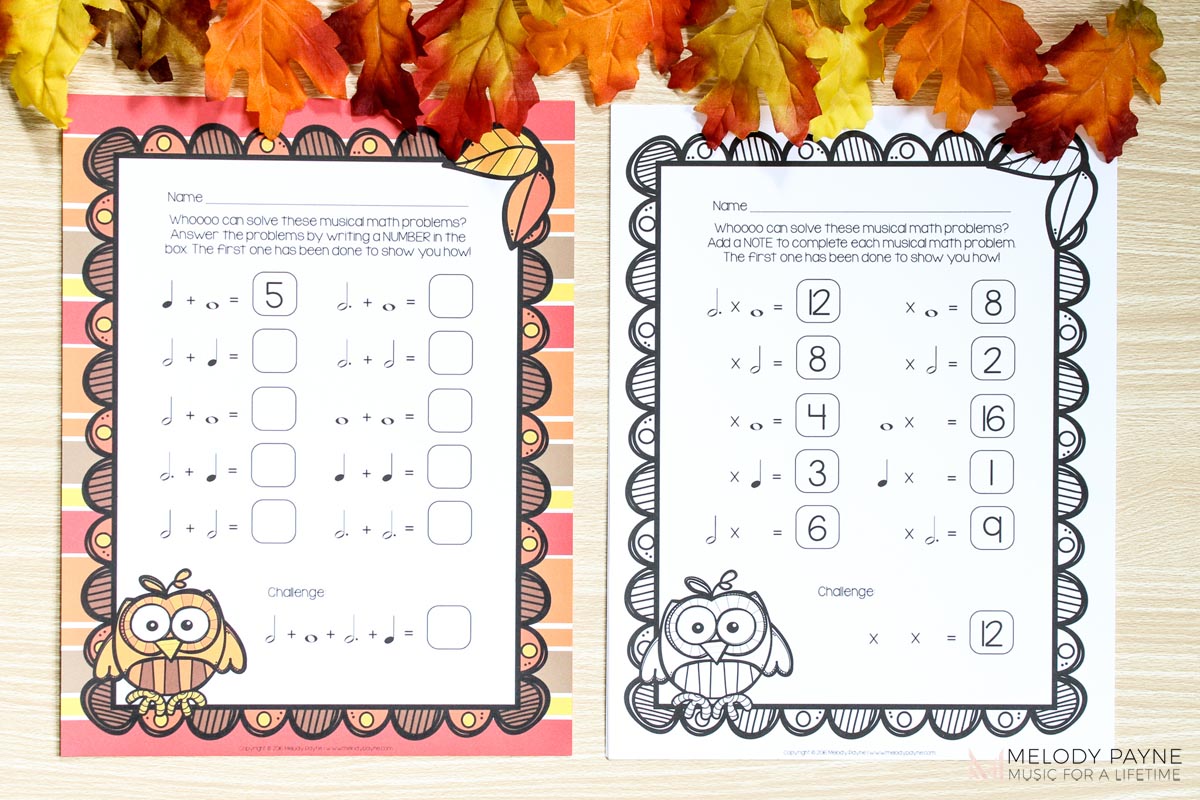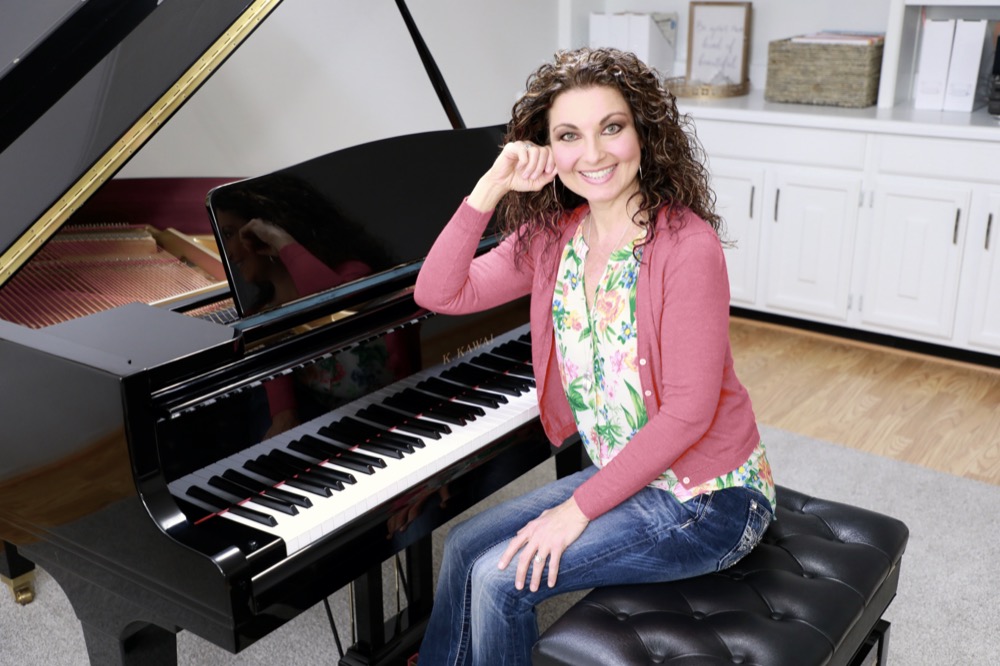4 Great Reasons to Use Fall Music Math Rhythm Worksheets
This post may contain affiliate links. If you purchase something through an affiliate link, I will receive a small commission at no cost to you. For more information, read the disclosure statement here.

Fall music math rhythm worksheets are a must-have for your studio this season if you are looking to start your students off on the right footing.
Teaching and reviewing rhythm is something all good teachers do anyway, so why not do it in a fun, seasonal way that is sure to be a hit with your students and is also very easy on your pocketbook?
(Though, if your students aren’t quite ready for this level of rhythm review, check out Preschool Rhythm Activity Cards for Engaging Piano Lessons.)
This economical set of ten color and ten black & white, printer-friendly worksheets is not only visually attractive, but also educationally sound.
Simple addition, subtraction, and multiplication are all required for the students to be able to successfully complete the pages.
Quarter notes, half notes, dotted half notes, and whole notes are the only note values that students need to know. What a great review for beginner and continuing students!
Before I list my four reasons to use these fall music math rhythm worksheets, let’s take a look at some of the pages.

- All of these fall music math rhythm worksheets feature a cute, clip art owl and a fall leaves border.
- For the first six pages in this package, the first music math problem has been done to show the student how to do it. Very helpful!
- The tasks are sequential, starting from the easiest tasks leading to the hardest ones by the tenth page.
- For example, the first page says, “Whoooo can solve these musical math problems? Answer the problems by writing a NUMBER in the box”. The student then simply has to add, for instance, a dotted half note to a whole note, and the answer is 7.
- The next page is similar, only students have to subtract.
- On the third page, students have to subtract the notes and write a NOTE rather than a number in the box as the answer.
- By the ninth page, students are multiplying three notes, such as [dotted half note X whole note X half note = ____ ], and they have to write a number in the box as their answer.
- By the tenth and hardest page, students will have reviewed their note values in many different ways and will be able to complete the task: “Add a NOTE to complete each musical math problem.” Then there is, for instance, [ ____ X whole note X half note = 16].
- There are challenge questions at the bottom of each page for students to complete as extra credit.
And now, here are my four reasons to use these fall music math rhythm worksheets:
1. Teaching & Reviewing Rhythm is Essential

No matter which instrument(s) we teach, all music instructors can agree that students must play rhythmically.
And mastering these first four, simple note values (whole note, dotted half note, half note, and quarter note) is the foundation for learning all other note values.
Maybe you’ve already “taught” your students these note values, but have they mastered them?
The sheer variety of activities contained in these fall music math rhythm worksheets ensures that your students will have a deeper understanding of these basic rhythms upon completion.
If you are frustrated because you’ve already taught your students these rhythms and yet they still don’t seem to “get” it, these fall music math rhythm worksheets are ready for you to print and go so you can give your students all the review they need.
Because they look fun and easy, your students won’t mind reviewing these essential rhythms in a brand new way!
2. There Are a Variety of Uses for These Fall Music Math Rhythm Worksheets

- These worksheets are useful for all instrumentalists, including drums, violin, cello, trumpet… I really can’t think of any musical instrument that doesn’t use these four note values!
- For classroom music teachers, these fall music math rhythm worksheets are perfect for the sub tub, cross-curricular engagement, and as extra practice for students who say they are “done” their other work.
- For private music instructors, these worksheets provide extra, essential review of note values as well as math skills.
- For my small group piano classes this fall, I’ve printed off one full set of worksheets for every two students.
- I plan to pair them up and ask them to divide the sheets between the two of them as they see fit.
- I like to pair up more competent students with struggling students, so I’m expecting that the “harder” worksheets will be in the hands of the student who is more comfortable with these rhythmic values and the easier worksheet will end up with the student who needs a bit more review.
- Then, they will be given class time to complete these fall music math rhythm worksheets.
- Do your group piano students help each other? Mine do, and it does my heart good to see! I expect that without my saying so, students will help their partner complete the worksheets. Thus, learning will have taken place without the teacher necessarily having to play an active role.
- Speaking of which, these fall music math rhythm worksheets don’t have to be done during the music lesson; they can of course be assigned as homework.
- For even more ideas, check out 7 Ways to Use Music Math Worksheets in a Variety of Music Classes
3. Be Creative This Fall With Your Fall Music Math Rhythm Worksheets!
- If you decide to print the black & white version of these worksheets, students can color the frame and the owl after completing the page. Your more artistic students will love this!
- You can also print them onto fall-themed card stock for an extra special treat!
- Display the completed pages this fall on your studio bulletin board. When parents come in to drop off and pick up their children, they’ll be able to see some of the outstanding and beautifully presented rhythm work that has been done in your music studio.
- Can you think of a creative game that can be made with these fall music math rhythm worksheets? For example, can you make a game out of having students clap the rhythms on the page once they’ve finished it? Let us know in the comments below!

4. These Worksheets Save You Time and Money!
- For less than just a few dollars, you can have these fall music math rhythm worksheets to use every fall for years to come.
- Save on ink and paper entirely by displaying these pages one by one on a big screen at the front of your classroom and have students solve the music math problems orally.
- If you prefer to print, it takes very little time to print the pages. Just print and go; it’s that simple!
- If you just want your students to do the worksheet during lesson, slip it in a page protector or dry erase pocket and let them answer the problems with a dry-erase marker. You can reuse one sheet over and over again!
- If your students are begging for even more worksheets, check out Save Time With Over 200 Print-and-Go Music Theory Worksheets!
Music math really is a hoot with these creative, time and money saving worksheets. Grab yours today and get ready for fall rhythm practice!
Other blog posts you’ll love…
Don't miss out!
Follow on Facebook and Instagram, join the best Facebook group for piano teachers, and subscribe to the newsletter to get helpful teaching tips, resources, and tutorials delivered straight to your inbox every week.
Celeste-tina Hernandez
Celeste-tina Hernandez
Welcome!

Hi! I’m Melody Payne, a pianist and piano teacher, educational resource author, a fun-loving wife to the most wonderful and talented hubby I could ask for, and a lifelong learner who loves to share. I want to make your life as a music teacher easier by writing and sharing helpful and relevant music teaching articles, and by creating educational resources with your very own students in mind. If you are a parent who wants to enroll your child in piano lessons, I’d love for us to get started building those skills that can give your child a lifetime of musical enjoyment!

